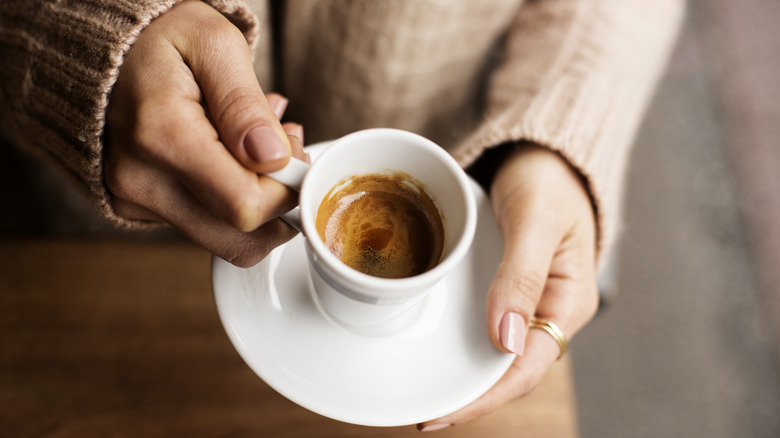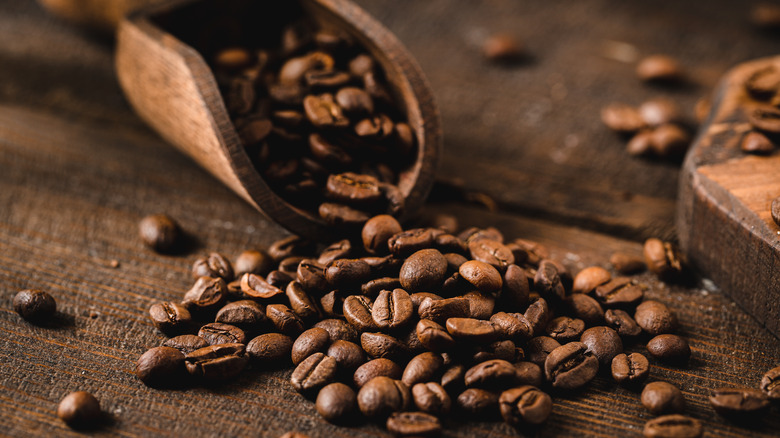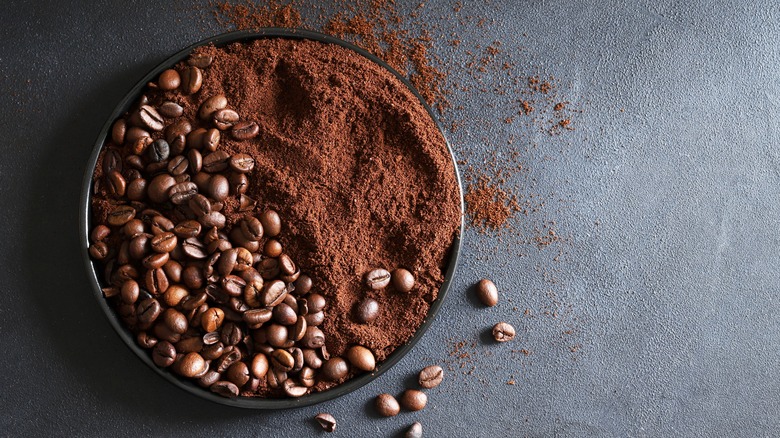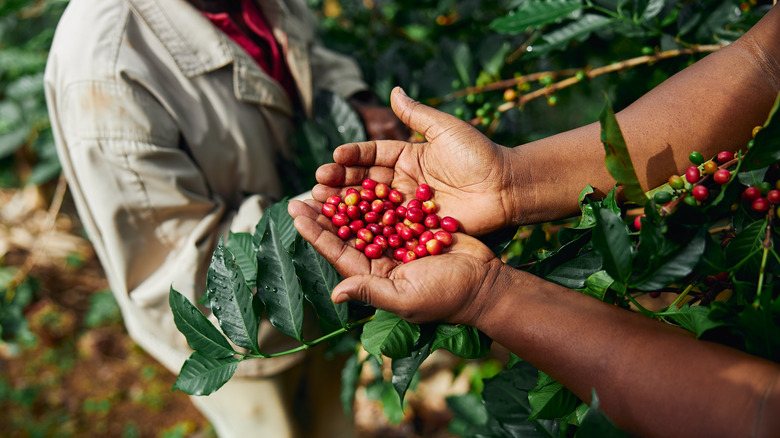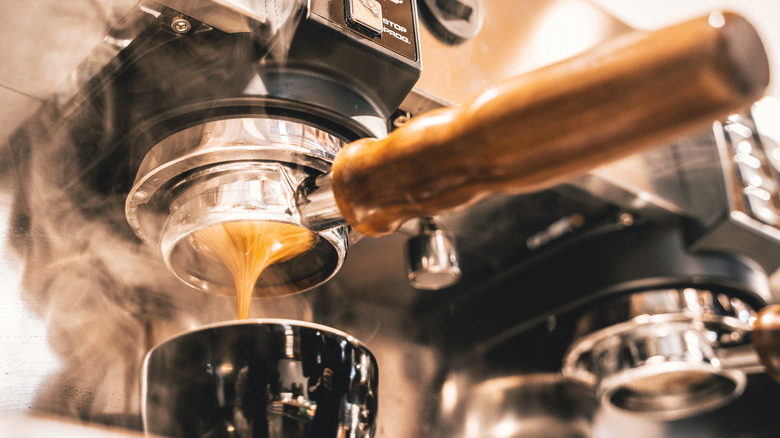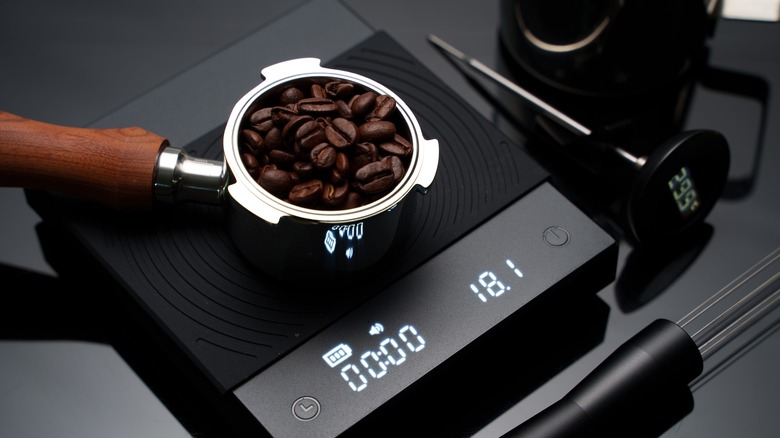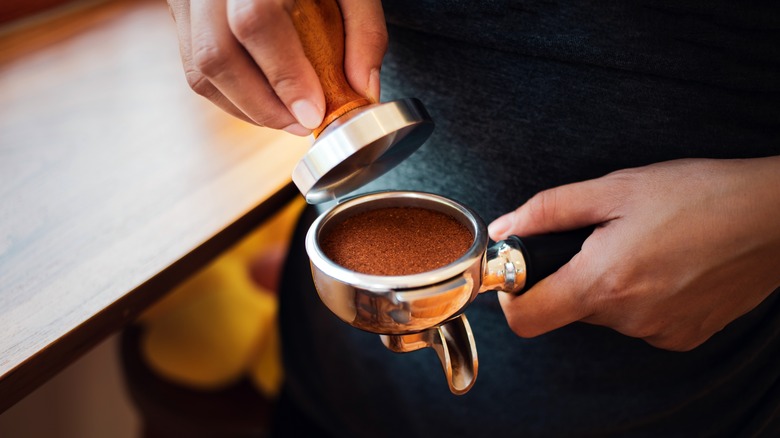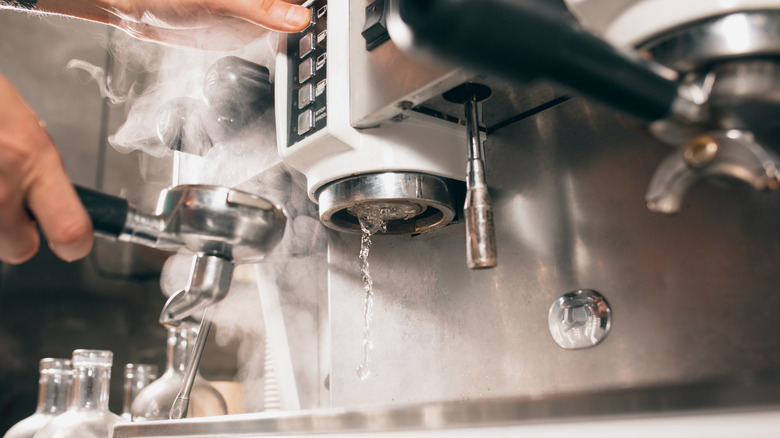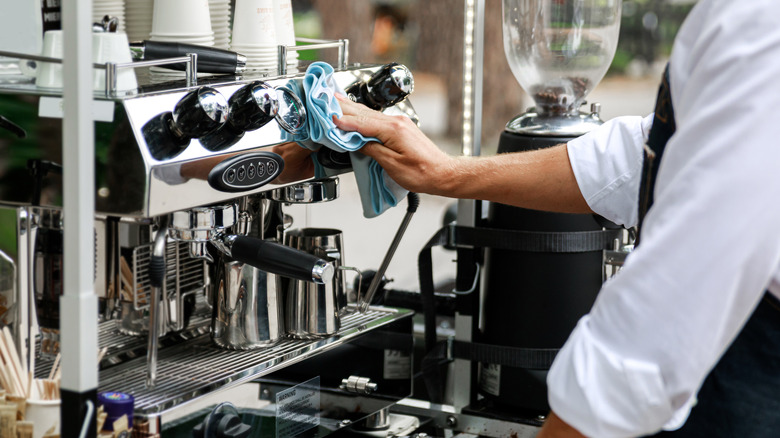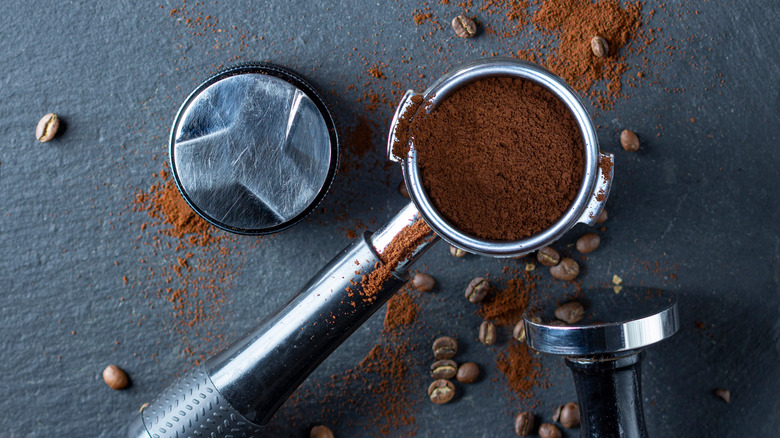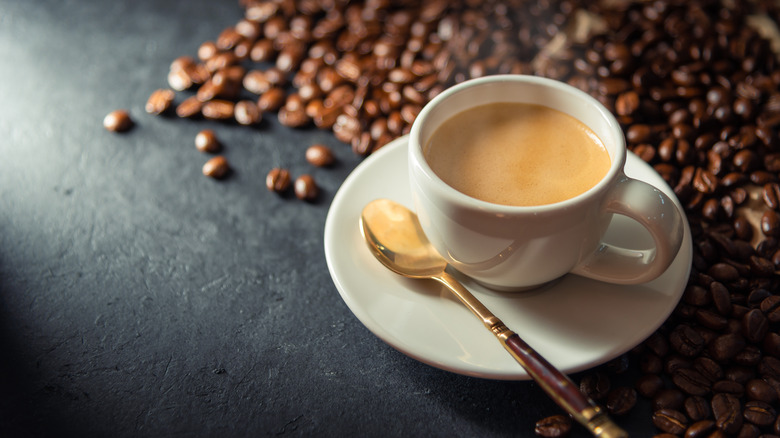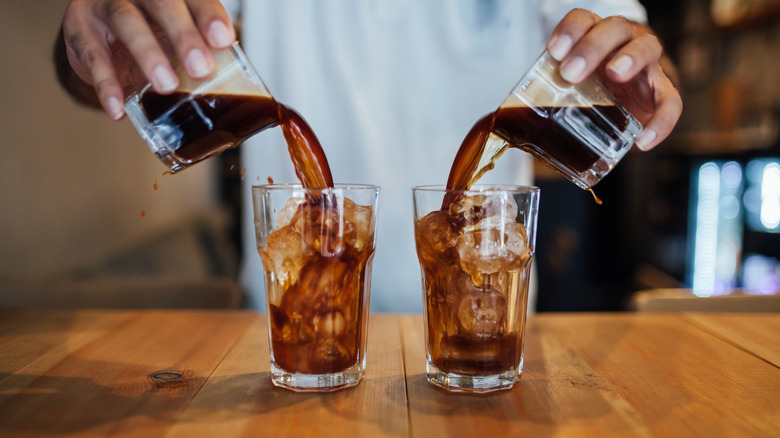Mistakes Everyone Makes When Making Espresso At Home
According to the U.S. National Coffee Association's National Coffee Data Trends report for 2023, around 65% of Americans have indicated that they indulged in a cup of coffee in the last 24 hours. Approximately 52% of these respondents reported drinking specialty coffee "brewed from premium whole beans or ground varieties" within the last seven days. These figures demonstrate that coffee isn't just an integral part of the daily routine for many Americans, but also that there's a noteworthy demand for expertly brewed coffee — including espresso.
Espresso is a rich and aromatic beverage enjoyed in the form of shots or as the base for other coffee drinks such as lattes and cappuccinos. It's prepared by passing hot water through finely ground coffee beans. The standard method for making espresso involves an espresso machine, but in a pinch, you can also prepare the caffeinated beverage using a French press (that being said, we can't guarantee the quality of the final result).
When prepared correctly, espresso has an indulgent and robust flavor profile. Conversely, if mishandled, the beverage can taste bitter and burnt. So, what should you avoid doing to ensure that your espresso turns out perfect? Here's a list of mistakes everyone makes when making espresso at home.
Not storing the coffee properly and using stale beans
The adage "fresh is best" is a cornerstone of culinary excellence. This principle also extends to coffee beans. Coffee that has gone stale lacks the vibrant aroma and flavor found in fresh beans, along with the nuanced qualities of recently roasted coffee. The bitterness of the coffee can also increase as a consequence of various compounds breaking down during the oxidation process when newly roasted beans come into contact with air. One of the signs that your coffee has gone stale is a lackluster appearance, a result of the gradual evaporation of the natural oils that give newly roasted beans their glossy sheen.
While experts say that ideally coffee beans should be used within a week of roasting, storing them properly can prolong their freshness. Some coffee products are packaged in valved bags, designed to allow the release of carbon dioxide while preventing the entry of oxygen, which could cause the beans to oxidize. Alternatively, you can store the coffee in an airtight, opaque jar or container that blocks oxygen, moisture, and light. This method also safeguards your coffee from absorbing any undesirable odors from your kitchen or refrigerator.
Using pre-ground coffee beans
There's no avoiding it — coffee begins to degrade in flavor and aroma the moment it's roasted. Grinding speeds up this process dramatically by increasing the coffee's surface area. In fact, the clock starts ticking fast. It's estimated that coffee loses around 60% of its aroma within the first 15 minutes of being ground. There are several reasons for this. Coffee beans contain volatile compounds responsible for the product's distinctive flavor. Grinding the beans increases the exposure of these compounds to air, speeding up their degradation. In addition, ground beans are more susceptible to absorbing moisture, which can further compromise the quality of the coffee over time.
Specific brewing techniques require different grind sizes. For instance, coarse coffee grounds are ideal for French presses and percolators, while fine coffee grounds are normally used for espresso. The use of an inappropriate grind size can result in over-extraction or under-extraction, ultimately leading to a subpar cup of coffee. By grinding your coffee beans immediately before making your espresso, you can ensure that the final product isn't just fresh, but also optimal for your chosen brewing method.
Not paying attention to the origin of your beans
Coffee beans are grown in around 70 countries, with approximately 50 of these nations actively participating in the global coffee export market. As such, coffee lovers have a lot of choices when it comes to selecting their favorite brew. So, how do you decide which coffee beans to try next?
The taste and aroma of coffee vary depending on its country and region of origin, the type of plant it comes from, and the processing methods. Predictably, environmental elements of a specific region, including climate, soil, and altitude, shape the beans' unique characteristics. For instance, Asian beans often feature an earthy flavor profile, African coffee is renowned for its complexity and fruity notes, and Central and South American beans are typically characterized by their clean and sweet taste.
It's important to remember that coffee isn't just a beloved beverage, but also a major commodity that fuels livelihoods in many regions of the world. While this may come as a surprise to many, coffee is the second most traded commodity in the world after oil. This is why you should be buying responsibly sourced coffee whenever possible. By doing so, you're not only supporting the communities that cultivate it, but also contributing to creating a more equitable industry.
Not understanding brew ratios
Just as you wouldn't attempt to make a complex dish without a recipe, you shouldn't pull an espresso shot without having some idea of brew ratios. For those uninitiated, a brew ratio is the relationship between the amount of coffee grounds and the amount of espresso extracted. The brew ratio plays a significant role in determining the strength and flavor of the coffee. An espresso normally has a 1-to-2 ratio, which means that for every gram of coffee, you extract 2 grams of espresso in a liquid form (double the weight of the coffee grinds).
That being said, the world of espresso-making is filled with endless possibilities, and part of the joy lies in the journey of discovering your ideal cup of espresso. Given that each individual has unique espresso preferences, feel free to experiment with various coffee-to-water ratios to discover the one that suits your taste. Nonetheless, the standard industry ratio of 1-to-2 is a great place to start your espresso-making adventure.
Not using a scale to weigh your beans
For many, espresso-making is an art form. This is why baristas and many coffee enthusiasts rely on precise measurements to achieve the desired strength and flavor profile of their coffee. After all, a scoop of ground coffee beans can vary in weight depending on factors like the type of beans, roast level, and grind size. Using a scale to weigh ground coffee is a great starting point for ensuring that you get uniform results each time you pull an espresso shot. More specifically, weighing your coffee beans will allow you to maintain the same coffee-to-water ratio every time you brew your beverage.
To obtain precise weight measurements, it's worth investing in a scale designed specifically for weighing coffee beans. For the best result, opt for a digital scale that measures weight in 0.1-gram increments and features a tare function. To weigh your coffee beans, place an empty portafilter or container on the scale and tare it. This will remove the weight of the portafilter from the final measurement, ensuring that you end up with the right amount of coffee grounds for a perfect shot of espresso.
Not tamping the espresso properly
Tamping in the context of espresso preparation refers to the process of compressing the coffee grounds in the portafilter basket prior to brewing. It's a crucial step in making a good espresso because it affects the flow rate of water through the coffee grounds and ultimately the flavor and quality of the shot. To cut a long story short, coffee grounds that are too loose can result in over-extraction and weak coffee, while grounds that are packed too tightly can lead to over-extraction and a bitter beverage.
A correctly tamped espresso means that the water passes through the coffee grounds at the right speed, extracting the oils from the grounds to ensure a rich and robust shot. To tamp the grounds, ensure that they are evenly distributed across the portafilter. Next, rest the portafilter on a level surface and press the ground with the tamper, packing them firmly, but not overly tightly. When tampering the grounds, it's recommended to apply 20 to 30 pounds of pressure. If you're not sure what this means, place your hand on a standard scale, and press down until the display shows 30 pounds. Once you've compressed the grounds, inspect them for any large holes, and remove any excess grounds clinging to the rim of the basket.
Not purging a little water before each shot
There are several reasons why baristas regularly run water through the espresso machine without the portafilter in place. Firstly, it helps to stabilize the water temperature in the device. Every time you remove the portafilter, air enters the lines, causing the unit to lose heat. Flashing the machine with hot water counteracts this temperature drop, ensuring a stable brewing temperature. If you're using a single-boiler espresso machine, flushing the group head can also cool it between shots, ensuring that the brewing water isn't overly hot.
Dispensing a small amount of water through the group head also removes any leftover grounds that may have become stuck the last time you pulled an espresso shot. After all, any remnants of previously pulled coffee can contaminate the flavor of the current brew. If you're making cappuccinos or lattes, it's also important to purge the steam wand on your espresso machine after frothing milk. This prevents any milk or condensation buildup inside the wand.
Using the wrong kind of water
Espresso is composed of just two ingredients: water and coffee. In fact, the average coffee is composed of 98% water while espresso is composed of around 90% water. Consequently, it comes as no surprise that the quality of water plays a pivotal role in shaping the flavor and aroma of espresso. More specifically, various minerals and impurities in the water can have an adverse impact on the extraction process and the final flavor profile of the espresso. Therefore, when brewing espresso, it's best to use filtered water since it tends to have a lower mineral content and level of impurities than tap water. If your espresso machine doesn't already come with a water filter, it's best to invest in one.
When it comes to espresso, the mineral composition of water can be a tricky subject. This is because water rich in minerals can result in over-extraction and bitter espresso. Conversely, water that's too low in minerals can result in under-extraction and a weak coffee. In addition, water that's overly rich in minerals and impurities can actually clog up and damage your espresso machine over time. However, if you think that using distilled or reverse osmosis water to pull your espresso is a good idea, think again. Since this type of water is almost mineral-free, it can actually leach minerals out of the pipes and boilers in your espresso machine, leading to corrosion.
Not regularly cleaning your espresso machine
Cleaning your espresso machine on a regular basis is an absolute must, not just for the sake of a great cup of coffee, but also for the longevity of your equipment. This is because any impurities, oils, and mineral deposits that accumulate in the nooks and crannies of your espresso maker won't just affect the taste of your brew, but can also lead to clogs and blockages within the device. In the worst-case scenario, if left uncleaned, limescale buildup can lead to the complete breakdown of your espresso machine.
The frequency with which you should clean your espresso machine depends on how often you use it. For instance, barristers in coffee shops should clean their equipment much more frequently than coffee enthusiasts who use their coffee machines on a sporadic basis. The best way to clean the portafilter and any other loose bits and bobs is to soak them in a bucket of hot water with a cleaning solution such as Cafiza. It's also important to frequently wipe down the exterior of the machine — we recommend doing this as soon as you notice any spills. Another crucial maintenance procedure is cleaning the group head using a "blind" hole-less portafilter basket, which normally comes with any espresso machine.
Leaving your grounds sitting in the portafilter basket
Leaving coffee grounds in the portafilter basket is frowned upon by coffee connoisseurs and baristas alike, and for good reasons. One of the problems is that old coffee grounds are saturated with moisture, leading to the growth of mold and bacteria. In addition, the longer the grounds sit in the basket, the more difficult they can become to clean.
To keep your espresso machine clean and your coffee at its peak, it's best to dispose of the used grounds immediately after making each shot. This prevents the buildup of oils and residues that can negatively affect the flavor of your espresso, and ensures that your machine is ready for the next espresso. Perhaps one barista on Reddit sums this practice up best saying, "At my coffee store we clean out the head right away if it's slow (right after handing off the drink). We know that if it sits there for a while, it will be harder to clean off quickly. When we're busy, we know we're about to make a new drink nearly right away, so we just wait until we're ready to pull our next shots to clean it out."
Not removing the crema off your espresso
The crema is a golden-brown froth that sits on top of the espresso and is composed of tiny bubbles of carbon dioxide, as well as coffee oils and fats. While some believe that crema provides a layer of complexity and flavor to a shot of espresso, others say that it adds an unappealing quality to the beverage. At the end of the day, it seems that whether you leave the crema on your coffee or scoop it out, depends on how bitter you like your brew.
Since crema has a bitter taste, scraping it off or mixing it into the shot generally leads to a more balanced and sweeter brew that's less likely to coat your mouth with foam. Maria Yagoda from Food & Wine, who tasted two espressos at the Jacobsen & Svart Coffee Roasters, observes that they had a completely different flavor profile once the crema was removed from one of the shots. "The range of flavor in the espresso without crema was fuller and spoke more specifically to this particular bean, which was earthy, fruity, and slightly savory," she writes.
Not brewing (or using) espresso for cold brews
Cold brew coffee is a method of brewing that involves steeping ground coffee beans in cool water for an extended period of time, typically between 12 and 18 hours. This slow, low-temperature extraction process usually results in a rich and smooth brew with a lower acidity level than coffee brewed in hot water. In addition, cold brew normally doesn't have the usual strong aroma of coffee. Cold brews are typically served straight, over ice, or with milk.
So, what makes espresso cold brew different from regular cold brew coffee? The distinction is quite simple — cold brew is made with coffee beans that are typically used in espresso machines. This means that the beans have been roasted to a level that's optimal for espresso extraction, resulting in a rich flavor profile that's not as intense as a traditional espresso. Cold brew espressos are less bitter and acidic and slightly sweeter than their traditional counterparts.
